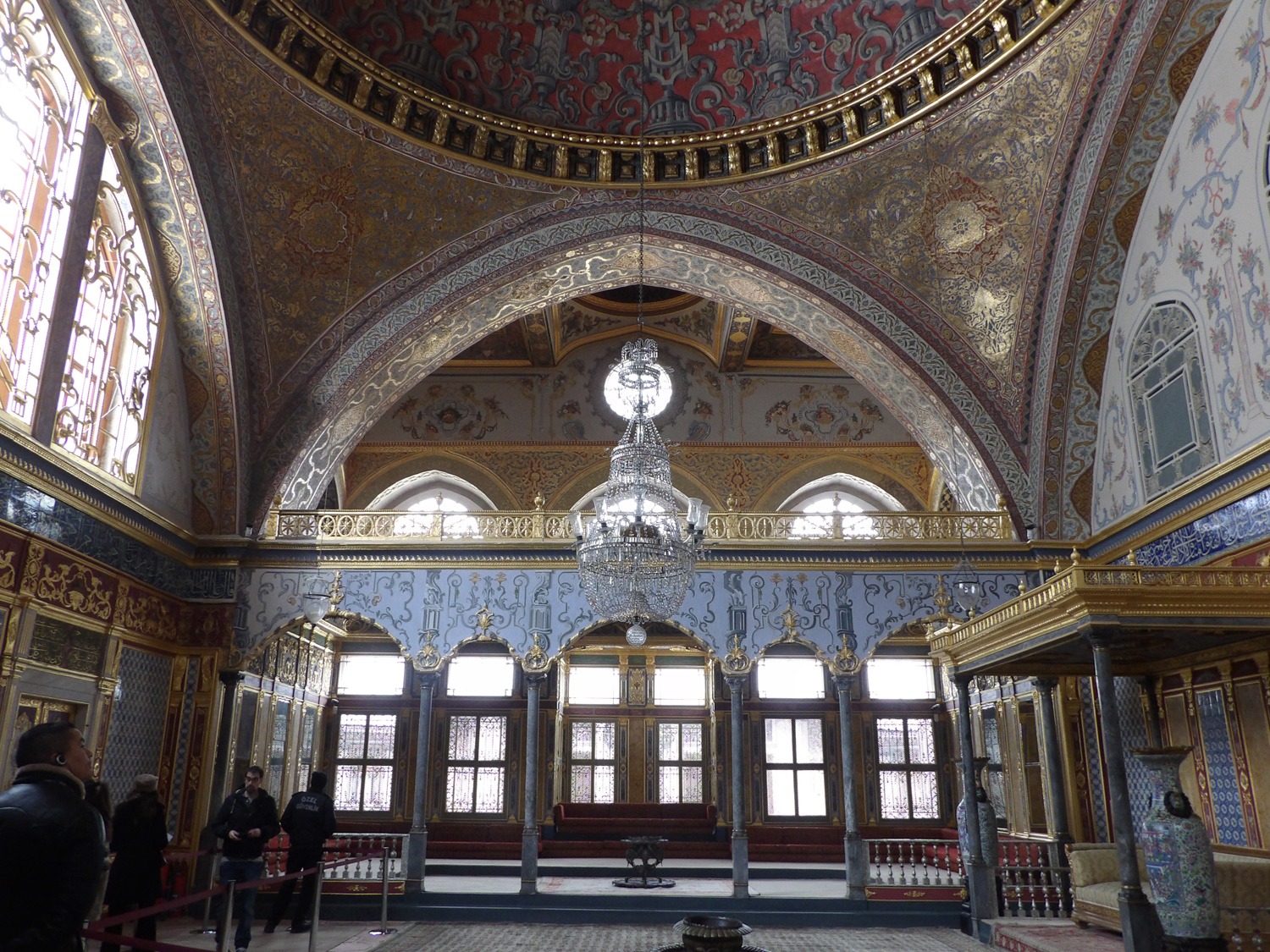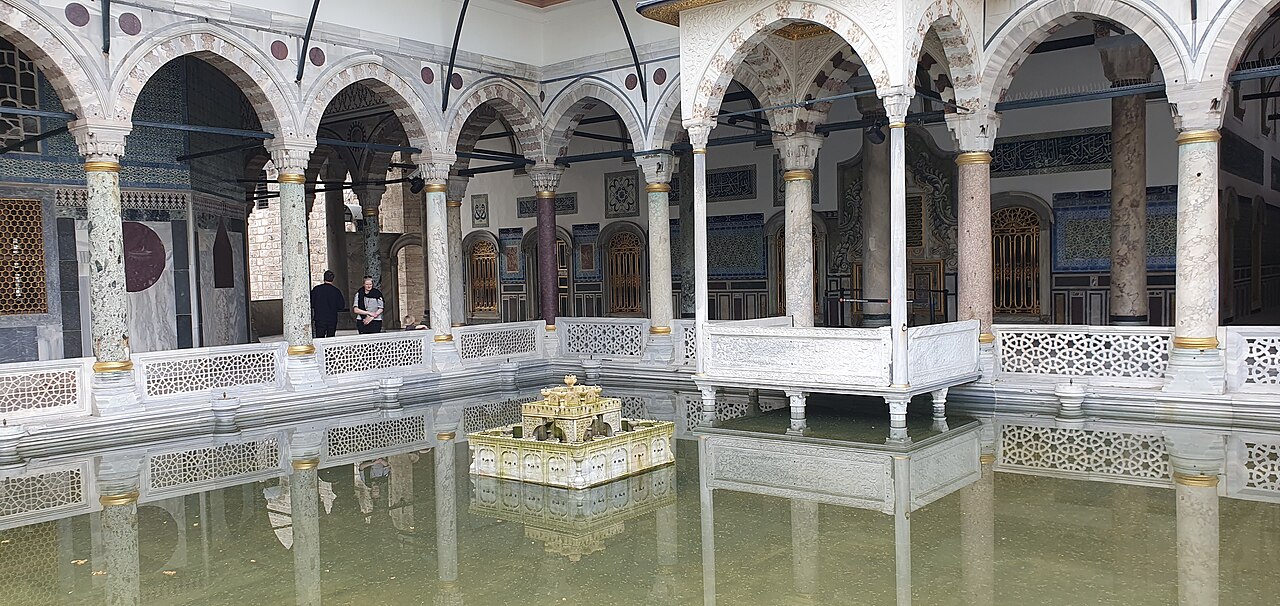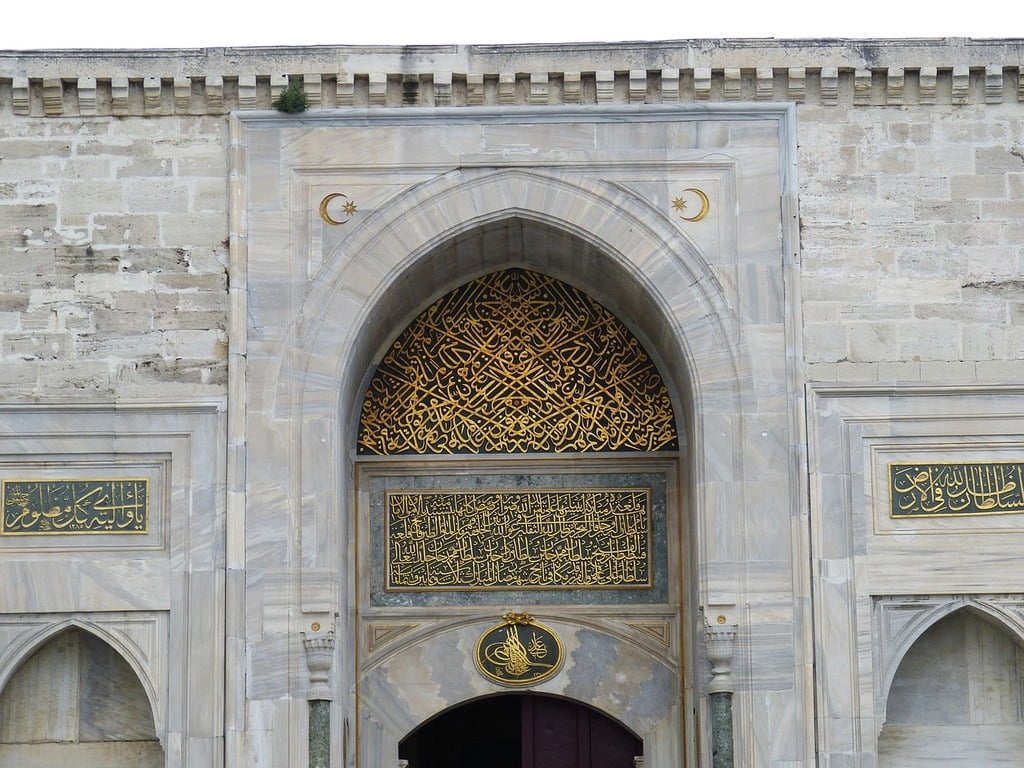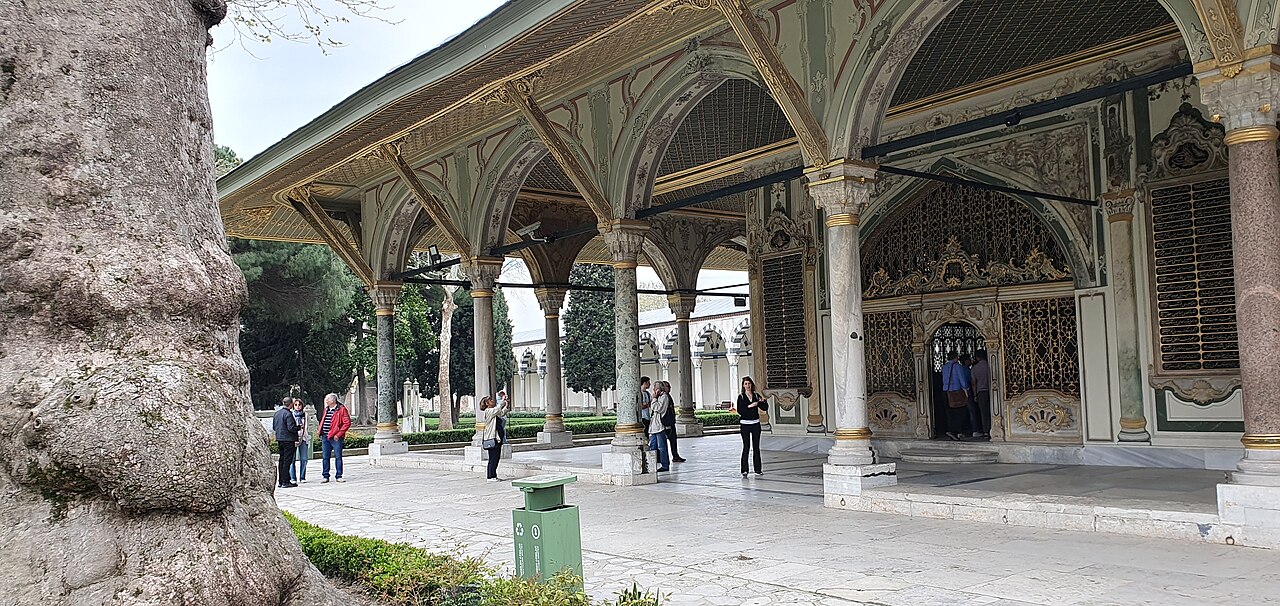Used as the administrative center of the Ottoman Empire and the residence of the sultans for nearly 400 years, Topkapi Palace is located in Istanbul’s historical peninsula, at Sarayburnu. Built in the 15th century by the order of Sultan Mehmed the Conqueror, this magnificent structure holds great political and cultural significance. Situated with a commanding view of the Sea of Marmara, the Bosphorus, and the Golden Horn, the palace fascinates visitors with its architecture that reflects the power and elegance of the Ottoman Empire. Over the years, the palace complex expanded with various additions and consists of courtyards, pavilions, chambers, and service areas.
Today serving as a museum, Topkapi Palace offers visitors a unique window into Ottoman life. It houses a wide collection ranging from sections displaying sacred relics to sultans’ kaftans, precious jewels, and miniatures. Especially the Harem, one of the most intriguing parts of the palace, offers clues about the private life of the sultan’s family. Visited by millions of local and foreign tourists every year, this historic structure continues to be one of Istanbul’s most important landmarks.
Where is Topkapi Palace?

Topkapi Palace is located within the district of Fatih, in the Sultanahmet neighborhood, one of the oldest and most historical areas of Istanbul. The palace is situated on the Historical Peninsula, at Sarayburnu, where the Sea of Marmara, the Bosphorus, and the Golden Horn meet. This strategic location provided the Ottoman sultans with a great advantage both for defense and for overseeing the city. Additionally, the palace is in the same area as other important historical structures of Istanbul, such as the Hagia Sophia, the Blue Mosque, and the Basilica Cistern. In this way, it is also at the center of a historical walking route for visitors.
Today, reaching Topkapi Palace is quite easy. It can be accessed by taking the tram to Sultanahmet stop and walking from there. It is also reachable by other public transportation options such as buses, ferries, and Marmaray. Since the palace is located right behind Gülhane Park over a large area, its entrance gate is quite prominent. Being one of the first places tourists visit when they come to Istanbul, Topkapi Palace is an indispensable stop in the city due to both its central location and its magnificent atmosphere.
How much is the entrance fee to Topkapi Palace?

Topkapi Palace is one of Istanbul’s most important historical structures and welcomes millions of local and foreign visitors every year. As of 2025, the entrance fees of the palace have been updated. For local visitors, the entrance fee to Topkapi Palace is set at 350 TL, the Harem section at 200 TL, and the Hagia Irene Museum at 150 TL. Discounted ticket prices for students aged 18–25 are 150 TL, 100 TL, and 75 TL, respectively. Admission is free for citizens of the Republic of Turkey aged 0–18.
For foreign visitors, the prices differ. The entrance fee to Topkapi Palace is set at 2000 TL, the Harem section at 750 TL, and the Hagia Irene Museum at 750 TL. The Museum Card is valid for the main sections of Topkapi Palace, but separate tickets must be purchased for the Harem and Hagia Irene sections. Visitors are recommended to purchase their tickets online in advance.
Which days is Topkapi Palace open?

As of 2025, Topkapi Palace is open to visitors six days a week and is only closed on Tuesdays. The ticket offices of the palace open at 09:00 and close at 17:00; visiting hours are between 09:00 and 18:00. Entry to the palace is not possible outside these hours.
Whether Topkapi Palace is open during official and religious holidays varies depending on the specific day. Generally, the palace is closed on the first days of Ramadan and Eid al-Adha; however, it remains open on the following days of these holidays. For example, in 2025, the palace will be closed on March 30, the first day of Ramadan Feast, but will be open on the second and third days.
Additionally, as of 2025, special night tours are organized every Saturday evening between 21:00 and 23:00. These tours offer a unique opportunity for visitors who wish to experience the palace’s nighttime atmosphere.
How much time should be spent at Topkapi Palace?
The amount of time visitors should allocate to visit Topkapi Palace may vary depending on the scope of the tour and individual interests. For visitors who wish to quickly tour the main sections of the palace, 1 to 2 hours may be sufficient. However, for those who want to explore the rich historical and cultural heritage of the palace in more depth, it is recommended to allocate at least 3 to 4 hours. Within this time frame, the main sections such as the courtyards, sultans’ chambers, the sacred relics section, and the treasury can be comfortably visited.
If you also wish to include additional sections such as the Harem and Hagia Irene in your visit, the duration of your tour may extend up to 5 hours. These areas are among the most popular and detailed sections of the palace. Moreover, considering factors such as heavy visitor traffic and ticket queues, it is beneficial to allocate extra time when planning your visit. It is especially important to note that the palace may be more crowded on weekends and public holidays.
To make your visit more efficient, you can consider options such as purchasing tickets online and joining guided tours. This way, you can both save time and gain more detailed information about the palace’s history.
How to get to Topkapi Palace?

Transportation to Topkapi Palace is quite easy thanks to its location in the central and touristic area of Istanbul. The palace is situated within the district of Fatih, in the Sultanahmet neighborhood, very close to Hagia Sophia and Gülhane Park. The most convenient way to reach it is by using the T1 Kabataş–Bağcılar tram line and getting off at the Sultanahmet stop. From this stop, it is approximately a 5-minute walk to the palace. Since the tram line passes through central points such as Eminönü, Karaköy, Gülhane, and Kabataş, it is ideal for those arriving by public transport.
Alternatively, visitors arriving by Marmaray can get off at Sirkeci Station and walk through Gülhane Park to reach the palace. For those who wish to walk from Eminönü, it is also possible to reach the palace via a pleasant walking route after crossing the Galata Bridge. For those coming by private car, although there are parking lots nearby, due to the density in the historical peninsula, public transportation is recommended. Using the Istanbulkart for transportation will be both an economical and practical choice.
Which sections can be visited in Topkapi Palace?

Topkapi Palace is spread over a large area and offers visitors different sections that reflect many aspects of Ottoman palace life. The palace has four main courtyards and many special sections. The First Courtyard (Alay Square) is the outer courtyard of the palace and is connected to Hagia Sophia; here, the entrance to Gülhane Park and the Hagia Irene Church are located. The Second Courtyard is where official ceremonies were held, and here are the Imperial Council (Divan-ı Hümayun), the Tower of Justice, the Palace Kitchens, and the Royal Stables. After this courtyard, visitors pass into the Third Courtyard; here are the Inner Palace (Enderun), which was the private area of the sultan, the Chamber of Sacred Relics, the Audience Chamber (Arz Odası), and the Library of Ahmed III.
One of the most striking sections of the palace is the Harem. This is the private living area of the sultan and his family, and it can be visited with a separate ticket. In the Harem, there are special sections such as the Apartments of the Queen Mother, the Corridor of the Concubines, and the Sultan’s Private Apartments. Additionally, pavilions and viewing areas such as the Baghdad Pavilion, the Revan Pavilion, and the Iftar Pavilion are among the must-see places. In the Treasury, valuable jewels, thrones, and swords belonging to the Ottoman Empire are exhibited. Visitors who want to fully explore Topkapi Palace should definitely allocate time for these sections.
What is the entrance fee for the Harem section of Topkapi Palace?

The Harem section of Topkapi Palace is one of the most private and intriguing parts of the palace, and a separate ticket is required to visit this section. As of 2025, the entrance fees for the Harem section are as follows:
For local visitors: 200 TL
For foreign visitors: 750 TL
Discounted ticket (student) price: 100 TL
The Museum Card is not valid for entrance to the Harem section; therefore, a separate ticket must be purchased for this area. It is advisable to keep this in mind when planning your visit.
Is there a guided tour at Topkapi Palace?

Yes, guided tours are available at Topkapi Palace, and these tours are very useful for visitors who wish to better understand the rich history and architecture of the palace. Guided tours generally cover the main sections of the palace and the Harem. Through these tours, you can gain detailed information about the history, architectural features, and use of different sections during the Ottoman period.
Apart from guided tours, if you prefer to explore on your own, audio guide options are also available. In this way, you can receive information about the different sections of the palace and tour at your own pace.
When planning your visit, it is recommended to make a reservation in advance according to the type of tour you prefer. This will allow you to enter without waiting in line and ensure that the guided tour slots are not fully booked, especially during the high season.
Is photography allowed in Topkapi Palace?

There are specific rules regarding photography at Topkapi Palace. In general, photography for personal use without professional equipment is allowed in the palace’s outdoor areas (such as gardens and courtyards). However, photography and video recording are prohibited in the palace’s indoor areas, especially in sensitive sections such as the Chamber of Sacred Relics and the Harem. This restriction is implemented to prevent damage to the artifacts from flashlights and to manage the flow of visitors.
During your visit, it is recommended to check the information boards at the palace entrance or ask the staff to learn about the current photography rules. In this way, you will comply with the palace regulations and ensure a smooth visit.
What is the history of Topkapi Palace?

The history of Topkapi Palace dates back to the rise of the Ottoman Empire, specifically to the conquest of Istanbul in 1453. The palace was commissioned by Sultan Mehmed the Conqueror shortly after the conquest, with construction beginning in 1460 and completed in 1478. Serving as the official residence of the Ottoman sultans for nearly 400 years, Topkapi Palace also functioned as the administrative center of the state, an educational institution (the Enderun School), and a venue for official ceremonies. Thus, it was not just a residence but also the heart of the Ottoman administrative system.
Over time, as the sultans moved to more modern palaces like Dolmabahçe, Topkapi Palace’s administrative functions diminished, but its historical and symbolic importance was preserved. In 1924, immediately after the proclamation of the Republic of Turkey, it was opened to the public as a museum by the order of Mustafa Kemal Atatürk. Today, Topkapi Palace stands as the largest surviving palace complex from the Ottoman era and is considered one of the most important museums in the world due to its architectural richness and its collection of sacred relics, jewels, and historical documents.
Why is Topkapi Palace on the UNESCO World Heritage List?

Topkapi Palace, together with the Historical Peninsula of Istanbul, was included in the UNESCO World Heritage List in 1985. The main reason for this is that the palace is one of the outstanding examples of human heritage in terms of its historical significance as well as its architectural, cultural, and artistic value. Serving as the political and administrative center of the Ottoman Empire from the 15th to the 19th century, the palace also functioned as a religious center housing the most important sacred relics of the Islamic world. With this characteristic, it holds great significance not only for Turkey but also for world history.
UNESCO defines Topkapi Palace as “a cultural heritage of universal value.” In addition to being one of the most original examples of Ottoman architecture, the palace reflects a rich cultural history with its architectural layers shaped over centuries, artworks, miniatures, manuscripts, and decorative elements. In this respect, Topkapi Palace is not just a structure but also a multifaceted historical document contributing to the common heritage of humanity.
What sacred relics are exhibited at Topkapi Palace?

The sacred relics exhibited at Topkapi Palace consist of artifacts that are extremely important for the Islamic world and hold great religious and historical value. These sacred relics are preserved and displayed in a special section called the Chamber of Sacred Relics. When the Caliphate passed to the Ottomans during Sultan Selim I’s Egypt campaign in the 16th century, these relics were brought to Istanbul and meticulously preserved. Since then, they have become one of the most important treasures of the palace.
Among the most notable sacred relics exhibited are:
The Hair of the Prophet Muhammad (Sakal-ı Şerif)
The Blessed Mantle of the Prophet Muhammad (Hırka-i Saadet)
The sword, bow, letters, sandals, and water vessel used by the Prophet Muhammad
The Staff said to belong to Prophet Moses
The sword attributed to Prophet David
The pot said to belong to Prophet Abraham
Sacred belongings and weapons of the Four Caliphs, companions, and other prophets
These relics not only present visitors with a religious treasure but also offer a spiritual experience that allows a deep connection with Islamic history. The tradition of reciting the Qur’an continuously in the Chamber of Sacred Relics has also been maintained without interruption for centuries.
How many rooms does Topkapi Palace have?

Topkapi Palace is a palace complex spread over a very large area, making it difficult to define it by a specific “number of rooms.” However, according to general estimates, the palace houses more than 300 rooms and structures in total. Among these structures are the sultans’ apartments, servants’ quarters, council halls, kitchens, libraries, pavilions, and the harem sections.
The palace is organized around four large courtyards and expanded over time with the addition of many buildings. Especially the Harem alone consists of nearly 300 rooms, halls, corridors, and private sections. However, since Topkapi Palace as a whole features a modular architecture composed of many interconnected structures, if each section is considered separately, the number can increase even further. The sections open to visitors cover only a part of these rooms.
Who is the architect of Topkapi Palace?

It is difficult to attribute the architecture of Topkapi Palace to a specific name because the palace was built with the contributions of many architects over different periods rather than by a single architect. The initial construction process of the palace began in 1460 during the reign of Sultan Mehmed the Conqueror and was completed in 1478. The name of the architect who worked during this initial phase is not definitively known; however, some sources suggest that an architect named Atik Sinan was involved in the project.
In the following centuries, Topkapi Palace was significantly expanded, especially during the reign of Sultan Suleiman the Magnificent, with various additions made by the famous chief architect of the time, Mimar Sinan. Among the structures Mimar Sinan added to the palace are some pavilions, baths, and water systems. Thus, the architecture of Topkapi Palace is a multi-layered, period-shaped complex that bears the marks of many masters.
What is the difference between Topkapi Palace and Dolmabahce Palace?

The differences between Topkapi Palace and Dolmabahce Palace are quite striking not only in terms of architecture but also in historical period, function, and symbolic meaning. Here are the main differences:
🏰 1. Construction Period and Purpose of Use
Topkapi Palace was built in the 15th century by Sultan Mehmed the Conqueror and served as the official residence and administrative center of the Ottoman sultans for nearly 400 years.
Dolmabahce Palace, on the other hand, was built in the 19th century during the reign of Sultan Abdulmecid as part of the Ottoman modernization efforts. It is the new palace where the Western-style life and court protocol were adopted.
🏛️ 2. Architectural Style
Topkapi Palace was built in the classical Islamic-Ottoman architectural style. Its courtyard layout, pavilions, and open spaces stand out. It is a simpler and more functional palace.
Dolmabahce Palace, however, features a European architectural style combining Baroque, Rococo, and Neoclassical elements. It is more grandiose, ornate, and reflects the Westernized version of palace life.
🏠 3. Palace Life and Structural Layout
Topkapi was built for the sultan and state administration; it is functional with structures such as the harem, council hall, and treasury. The sultans lived a simpler lifestyle.
Dolmabahce was especially designed for protocol and lavish ceremonies; it is adorned with European-style ballrooms, crystal staircases, and enormous chandeliers.
📍 4. Location and Symbolic Meaning
Topkapi Palace is located in Istanbul’s Historical Peninsula and was the first major center established after the conquest by the Ottomans.
Dolmabahce Palace is located on the Bosphorus coast and represents the Western-facing side of the modernizing Ottoman Empire.
🔄 5. Change and Transition
Topkapi Palace symbolizes the classical period of the Ottoman Empire;
Dolmabahce Palace reflects the final periods of the Ottoman Empire, its Westernization efforts, and the changing understanding of governance.
Topkapi Palace, not only one of the most important structures of the Ottoman Empire but also of world history, carries the traces of the past into the present. With its architecture, its sacred relics, and its historical and cultural texture, this unique palace attracts millions of visitors every year and stands as a resilient heritage in the heart of Istanbul. This magnificent structure stretching from past to present is an indispensable stop for those who wish to witness history and embark on a cultural journey.

